| 1 | A South American river bully |
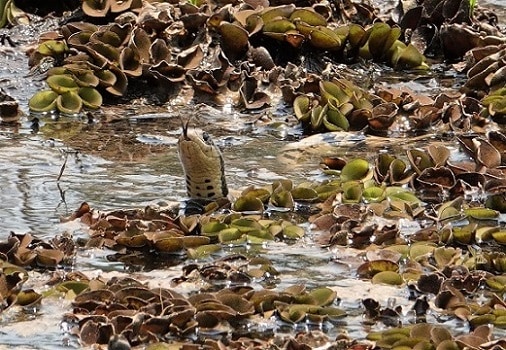
In the watery zones of Paraguay, southern Brazil and Argentina, there lurks a hidden monster serpent which few know about. This snake is the Brazilian smooth snake, which rarely appears in rainforests, but is abundant in estuaries, floodplains, rivers themselves, and small tributaries. Brazilian smooth snakes belong to the Hydrodynastes family, which has one further species nearby, the more exclusively aquatic Hydrodynastes bicinctus.
Adult Brazilian smooth snakes (Hydrodynastes gigas) are usually over 2 metres long, and 3 metres isn’t exceptional. Not only are they large, but they don’t have the associated slowness and lethargy like an giant anaconda. Brazilian smooth snakes are energetic snakes, which move through the water like a speedboat with a watchful and alert expression on their face. They spend virtually the whole day moving, whether swimming, climbing, investigating, analysing, charging, spying, or hunting.
Brazilian smooth snakes are active at day, and locals know them well, dubbing them ñacaniná. They’re mostly non-venomous, and have never killed a human being on record. Nevertheless, the Brazilian smooth snake could easily charge at a Westerner’s canoe and cause them to capsize in shock, having never read about this less famous water serpent at school.
| 2 | Flares its neck like a cobra |
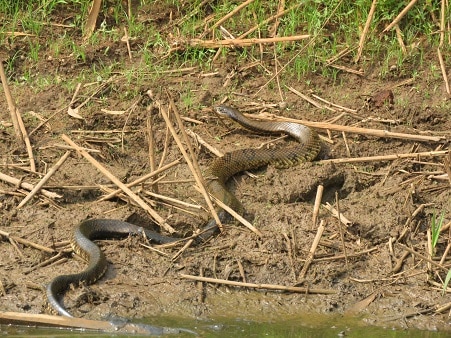
Some communities call this water serpent vibora ladradora, or barking snake, while another Western name is false water cobra. This references its defensive trick of flaring its body, in order to convince predators that they’re a bulkier opponent than they really are.
Unlike a cobra, Hydrodynastes gigas flares its neck while horizontal on the ground, rather than rearing its chest up vertically. But the flaring also reaches lower down on its body compared to the cobra, almost to its midsection.
Brazilian smooth snakes are considered to be a particularly intelligent species, which can be trained by keepers. Their aggression levels vary by individual. All are energetic and active, but some are calm and sail past humans, while others are aggressive and intimidating. They’re also confident; an angry Hydrodynastes gigas doesn’t even coil back and offer a warning, they just strike instantly. They’re even confirmed to whip people with their tails. If you dock your canoe and have a picnic lunch by the riverside, and a Brazilian smooth snake slithers past, then you might escape without harm, but equally, you might not.
| 3 | The ongoing venom debate |
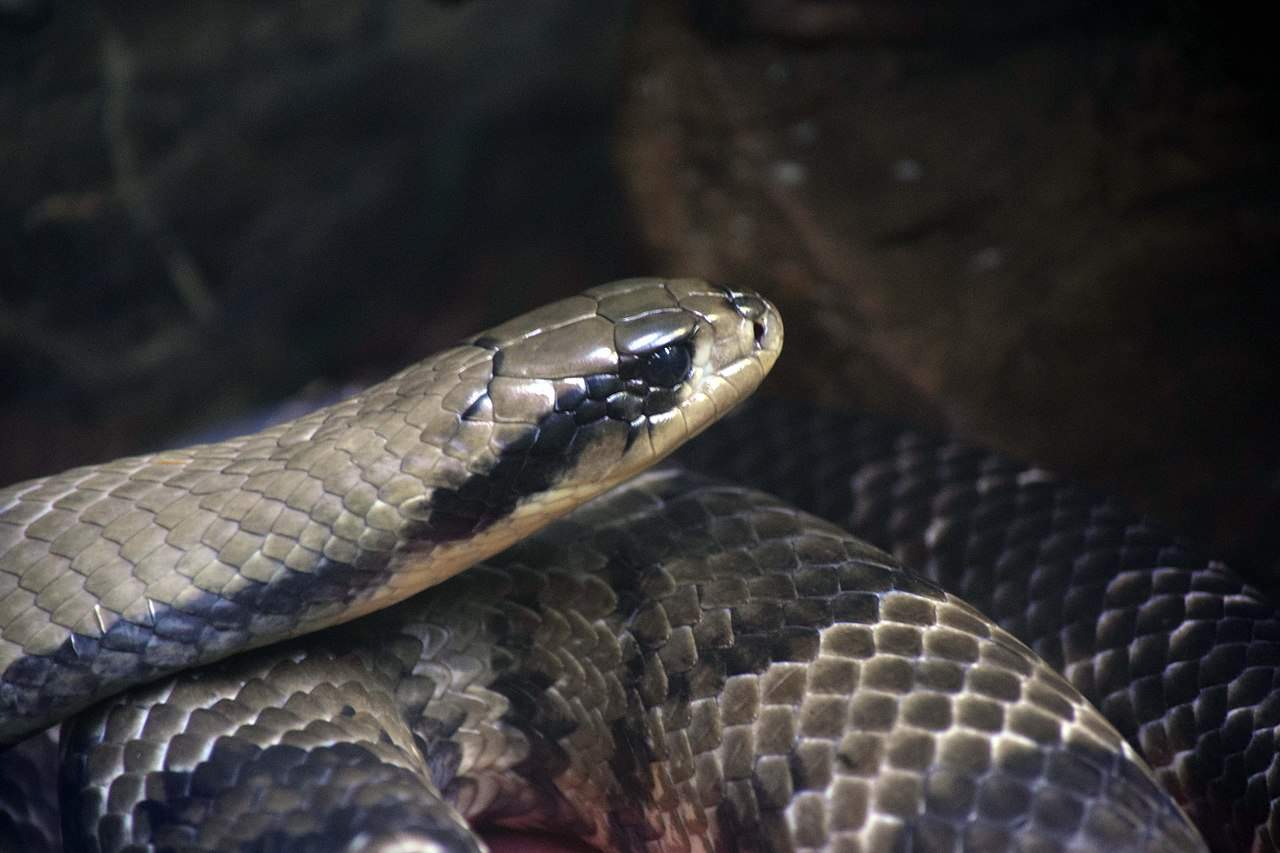
Brazilian smooth snakes have venom, but the exact potency is mysterious. Some believe that it matches a timber rattlesnake, while others dismiss the symptoms as psychomatic. Hydrodynastes gigas was thought to be venom-less for years, but it’s now confirmed that they secrete a mild, rear-fanged venom through their Duvernoy’s gland. Like the green whipsnake, this must be forced in manually via determined chewing.
One victim was an 18 year old pet shop worker, who was bitten on the left wrist for 1.5 minutes. Swelling kicked in quickly, and the guy swallowed two tablets of the antihistamine diphenhydramine. 9 hours later, the swelling expanded, and the boy developed muscle weakness and temporary paralysis. This was severe enough to make him fall over three times.
Blood tests revealed no abnormalities, and doctors blamed his symptoms on anxiety. However, the swelling took 5 days to subside, and the boy reported muscle pain and weakness for 2 further months. In a tale from the internet, a breeder was bitten by an adult Brazilian smooth snake, and ended up with a permanently disfigured arm. Bites can be mild like a bee or wasp swing, or your hand could swell to three times its normal size.
| 4 | The entire river is its prey |
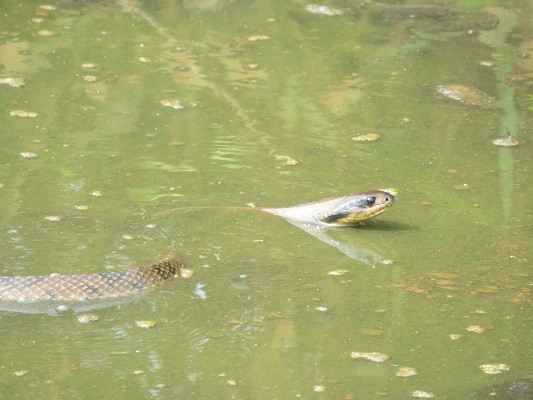
The Brazilian smooth snake is a dietary generalist, with a slight leaning towards frogs. With their large size, Brazilian smooth snakes are close to an apex predator in their watery ecosystems. Anything that strays into its rivers and tributaries is fair game, except crocodiles and maybe titanoboa if it still exists.
Two big studies have been performed on Hydrodynastes gigas’ diet and the results were pretty similar. A large study from northeast Argentina found a diet of 41.4% amphibians, 20% reptiles, 15.7% fish, and 14.3% mammals. A 2004 survey (also from northeast Argentina) had a similar order of preference: 30% amphibians, 26% other snakes, 22% birds, and 22% mammals. This study found that the prey were 7-39% of the snake’s body length, and one smooth snake had fish eggs in its stomach, probably swallowed by accident.
Birds are their least favourite prey, but they still eat them occasionally. Brazilian smooth snakes have the digestive skills to eat almost anything, even if their watery circumstances have pushed them towards amphibians and fish. Snakes are also a big part of their diet. In the first study, they were recorded eating the golden liophis (Erythrolamprus semiaureus) two times, a shiny snake which also likes rivers. The leopard keelback (Helicops leopardinus) also appeared twice, a snake which eats 70% fish.
| 5 | Particularly fond of eels |
Brazilian smooth snakes are notorious for dragging their prey into the water and drowning them. They also do the opposite. One time, a Hydrodynastes gigas was spotted coiling around a marbled swamp eel, which it then dragged out of the water and to shore. The eel broke free, but the snake instantly lunged and re-seized it, before swallowing its prey on the riverbank.
In the first diet study, the marbled swamp eel (Synbranchus marmoratus) was their most common prey species, alongside the Bella Vista granulated toad (Rhinella fernandezae). Each was recorded 7 times. The earlier 2004 study reached the same conclusion: the marbled swamp eel was the most common prey, being recorded 4 times.
Another common prey was the paradoxical frog (Pseudis paradoxus), one of the world’s most bizarre species. This amphibian measures up to 27cm as a tadpole, before shrinking as an adult, reaching one quarter of its former size. The marbled swamp eel is a very aggressive species which swallows any fish it is placed in a tank with. It can reach 1.5 metres long, and is able to power up waterfalls and reach upstream rivers. It gets its comeuppance by being the Brazilian smooth snake’s equivalent of bread and butter.
| 6 | The longest death-faking snake |
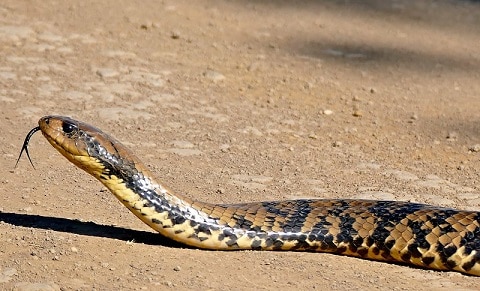
Hydrodynastes gigas likes to hunt in shallow water, investigating areas where eels lay their eggs. They acquire their meals with a bit of everything; chewing in a mild venom, charging at high speeds, and wrapping an incomplete coil around its prey to hold them in place before swallowing.
They often get impatient and swallow their prey alive. One time, scientists rescued a Hydrodynastes gigas from a riverside factory and stored it in a plastic box. While inside, it coughed up two cane toads, one partially digested and the other still alive. The scientists jotted this down and continued to watch the snake, which re-swallowed the living toad within minutes. Brazilian smooth snakes are also resistant to bufotoxins, as the cane toad is highly poisonous.
Playing dead is another trick up the Brazilian smooth snake’s sleeves. Hissing and neck-flaring is the standard, but a study found that 5 of 13 played dead when harassed. This makes them one of the largest snakes to use the play dead trick; it’s one thing being 40cm and flopping over, but Hydrodynastes gigas has to control 2.5 metres in its acting performance. They normally go completely limp, and sometimes loll their tongue out lifelessly.
| 7 | ID: blacker towards the tail |
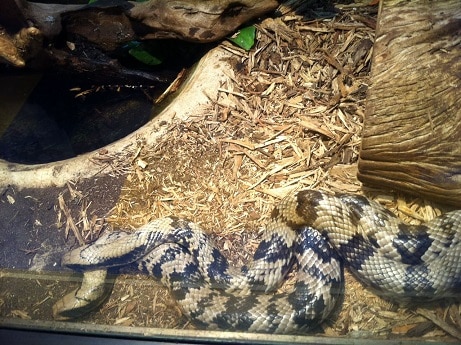
Brazilian smooth snakes mainly have black scales contrasting against brown, which varies from olive to yellow to almost gold. Females are longer than males, have bulkier heads, and a thicker body at the mid-section. Males specialise in brighter colours than females, and have a longer tail. This species has an oily black tongue, and black eyes with round pupils.
One sign makes ID’ing a Brazilian smooth snake easy – the black intensifies the closer you get to the tail, with some tails being fully black. The head is lighter, and there’s a long black stripe beginning from the eye and flowing backwards, like a clumsy paint swipe. Their belly varies from near white to light brown, with dark speckles.
From a bird’s eye view, Brazilian smooth snakes have a triangular-looking head. They also have a thin, triangular black line separating the neck from the head, like the seam in an action figure with a detachable part screwed on. Brazilian smooth snakes vary significantly in appearance, and ones with green or red tinges pop up sometimes. In 2007, a fully black enclave was found, so many more weird morphs could be lurking in remote rivers.
| 8 | Captivity: not impossible to keep |
Captive Brazilian smooth snakes normally require fish for their first few meals, but can be trained to eat rodents. They apparently calm down well in captivity, the one caveat being a hyperactive feeding response. Keepers have to be careful. Being so alert and focussed, it only takes the smell of rodents on your clothes for a Hydrodynastes gigas to swivel around and start snapping. They can also turn aggressive if you touch them on the neck, possibly because this is where bird predators first grab with their talons.
Keepers report that they barely climb at all, and prefer a terrarium in jungle floor style, with large pieces of mulched wood and bark. There’s no way that you can drape this pet around your neck like a boa constrictor; they’re too active and energetic and will probably slither off in alarm.
People have successfully bred them in captivity, dropping males into the female cages. One breeder had two females and a male, which got a turn with each, and each female produced 16 eggs. This tallies with sightings in the wild. Hydrodynastes gigas produces annually in its Brazilian river domains, and they also skip hibernation; they’re active the entire year.
| 9 | Their closest relative |
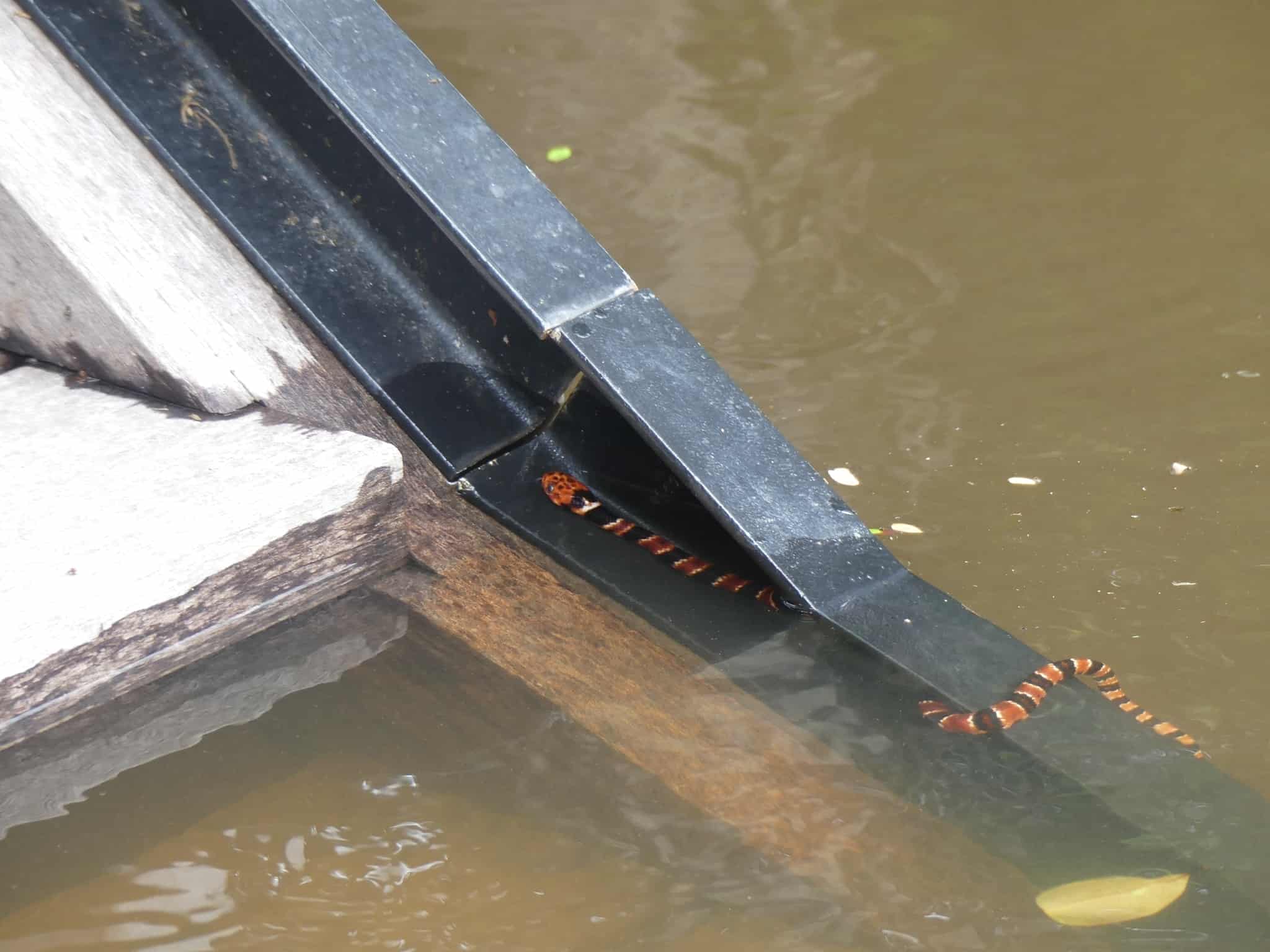
The only other snake in the Brazilian smooth snake’s family is Hydrodynastes bicinctus. Rather than subtle scale alterations, this version is noticeably different to the naked eye. The stripes are much more vertical and ordered, and contrast against each other sharply. Unlike the Brazilian smooth snake, Hydrodynastes bicinctus seems to be mimicking venomous coral snakes for protection, as the red, black and thin white bands have a strong resemblance. They too have a telltale pattern behind the eye, but instead of a straight line, this curves in a white C-shape.
Hydrodynastes bicinctus sticks to water more exclusively than Hydrodynastes gigas, and has an equally wide empire, covering a vast stretch of Brazil, but they live further overall, not being recorded in Argentina. They’re also significantly shorter than Brazilian smooth snakes, averaging at 1.15 metres rather than regularly surpassing 2 metres. H. bicinctus has just a fraction of its cousin’s research, but probably feeds on frogs and fish as well.
| 10 | The mysterious black subpopulation |
Confusion is also rife over whether a fourth, fully black species exists. In 2007, researchers were scouring a flooded hydroelectric dam in the Tocantins river, in the central Brazilian state of Tocantins. This is a tributary of the larger Araguaia river, and the researchers found 269 Hydrodynastes species members. They found numerous Hydrodynastes bicinctus, but apparently no Brazilian smooth snakes. Instead, they discovered a melanistic, coal black version with barely a hint of white. The stripe behind the eye was missing, the face was black. Only the belly was paler, but there were few patterns. The scientists declared this to be a new species: Hydrodynastes melanogigas.
But a 2020 study which returned to the Tocantins river scuppered this, concluding that melanogigas was really just a superficial colour variant. They couldn’t find a single difference to the Brazilian smooth snake other than the black colour. The scale counts and skull shape were identical. Genetics told the story; Hydrodynastes gigas and melanogigas had a mitochondrial DNA divergence of just 0.01%. The actual separate species, Hydrodynastes bicinctus, had a mtDNA divergence of 0.43%. It does show that weird morphs of many snakes are out there, waiting to be found. The green whipsnake is another one with a black subpopulation, without being a new species.
